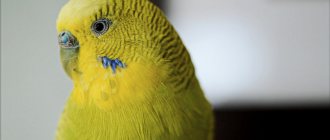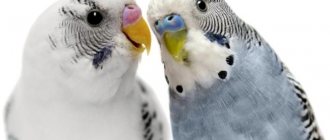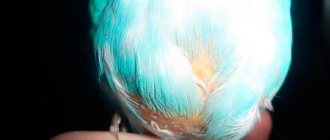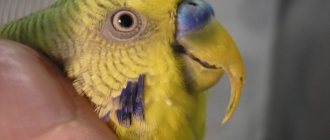- home
- Parrot
- Treatment
05/24/2019 The eyes are among the most important organs for a parrot - with their help, birds navigate in space. During the flight, the bird not only deftly maneuvers between surrounding objects (even moving ones), but also at the same time looks for a landing site. Parrots constantly look around, assessing the situation - of course, at home there is little threat to the bird, but this is a reflex inherent in nature. Having lost its vision, the parrot will become helpless and defenseless, so if you find problems with your pet’s eyes, you should contact a veterinarian.
Inflammatory processes
Inflammatory processes are considered the most common and one of the most dangerous risk factors for the development of blindness. Most often they are caused by:
- tobacco or cigarette smoke;
- chemically active substances and their fumes;
- dust;
- hydrogen sulfide;
- ammonia, etc.
If a parrot's eye is inflamed, most likely this is due to contact with one or more of the components dangerous to the pet that may be contained in the environment surrounding the bird. The parrot's body perceives the presence of these substances in the air as painful. Your pet's eyes are one of the first to suffer.
With inflammation called conjunctivitis, the bird constantly closes or squints its eyes. The bird has:
- redness of the organs of vision;
- discharge from the eyes, which causes the eyelids to stick together.
With unilateral conjunctivitis, the parrot closes one eye and crusts form on the eyelids.
If you are sure that the parrot is kept in a room with clean air without dangerous impurities, you should make sure that the room with the parrot's cage is not drafty - this can also cause inflammation. In such cases, the inflammatory process is a symptom of a cold, and not a parrot eye disease.
To treat and prevent inflammatory processes, it is necessary to exclude the parrot from contact with substances that provoke eye inflammation - that is, do not keep the bird in a smoky room, etc. It is also necessary to protect your pet from being in a draft, near open windows and vents, etc.
What drugs are used to treat eyes?
Depending on the nature of the disease, veterinarians prescribe drops, injections or ointments. The following medications are popular:
- Tsiprolet – eye drops, prescribed for the treatment of infections of the eye and its appendages;
- Indocollir - strong anti-inflammatory eye drops;
- FLOXAL - drops, long used in ophthalmology, destroys bacteria and relieves inflammatory processes;
- Vitabact - drops used to treat conjunctivitis;
- Korneregel is a gel that is prescribed to pet parrots for eye damage and inflammation.
It is difficult to choose the necessary medication on your own, since the treatment of certain diseases requires special active substances. Very often, veterinarians prescribe not only eye drops or creams, but also additional vitamins. The budgerigar's diet should also be varied with fruits and vegetables. It is important that the cage is thoroughly cleaned, which will protect the bird from additional sources of infection. Very often the eye is damaged due to long nails that need to be trimmed. This must be done carefully so as not to damage the blood vessels that are found in some nails and feathers.
A cold can also result in complications in the eyes, this happens due to improper treatment. An excess of antibiotics will cause dysbiosis, so it is necessary for the doctor to accurately calculate the dose of the drug.
Foreign body
Even a microscopic foreign particle or speck that gets into the eye causes an unbearable desire to get rid of it. A person in a similar situation rubs his “clogged” eye with his hand, and the parrot itches himself against the bars of the cage or other hard objects that are freely accessible.
Sometimes, in an attempt to get rid of a speck in the eye in any possible way, a feathered pet causes even greater damage to the organ of vision than the speck could have caused. Often, in addition to redness, the following is observed: the parrot’s eye has closed, the third eyelid has swollen and fallen out.
Shedding a budgerigar
From: Maria Tel.: 89264 Message: Good afternoon. I have two budgerigars: a 4-year-old boy and an 11-month-old girl. The girl was adopted in February, she flew, and the boy and I became friends right away. But in June she began to molt: her flight feathers began to fall out. gradually she stopped flying. in July I called an ornithologist, he prescribed Liarsin 2 drops, Hemavit 2 drops, vitrins in water for 7 days. At first there seemed to be an improvement, but then everything happened again. The feathers fell out again. I have now started taking these medications again. She gave it 10 days. No improvement. Tell me what could be the problem. Thank you in advance. -Good afternoon! You should find out the root cause of such molting in a parrot, for this you need to show it to a doctor from the bird hospital. Here it is necessary to take some tests for various pathogenic components that can lead the bird to this condition. In the meantime, I can recommend the drug Apterin and Town alternately for 1 month each. Sincerely, Vladimir Romanov
Xerophthalmia
This disease is caused by the lack of vital substances in the pet’s body, in particular vitamin A. But the causes of the disease cannot be ruled out by the negative impact of chemical substances on the visual organs. The essence of xerophthalmia lies in the following manifestations:
- sudden loss of visual acuity;
- blurred vision.
The disease must be treated immediately. Therapy is based on the bird undergoing a special course of medication and taking vitamin and mineral supplements. The specific treatment is prescribed by the veterinarian.
What to do if symptoms appear
- Do not self-medicate under any circumstances.
- At the first symptoms, consultation with an ophthalmologist is necessary.
- Initiate necessary therapy in a timely manner
- Maintain hygiene
If the inflammatory process appears only in one eye , without timely treatment the process can spread to the healthy eye.
It is important to promptly identify inflammatory processes in children; we must remember that children rarely complain of visual discomfort.
Cystosis
To some extent, this disease is similar to conjunctivitis. They can be distinguished by the area of inflammation. If conjunctivitis affects the entire organ of vision, then with cystosis the inflammation affects exclusively the lower eyelid.
If a parrot's eye is closed, and the lower eyelid is swollen and a purulent accumulation is visible inside it, this is cystosis. The parrot needs urgent professional treatment. It is worth noting that the problem of suppuration in the eyelid with cystosis can only be solved by surgical intervention.
A budgerigar's lower eyelid is swollen
From: Elena Tel.: 89152 Message: Good evening! Please consult! We bought budgies in June. The boy quickly adapted, but the girl was weak and hardly chirped. Then she began to notice that her lower eyelid was swelling. They applied floxal and after five days everything went away, but a week later the swelling returned. Then she gave Baytril drops and the same thing happened again. It turns out that as long as you give the medicine, the swelling of the lower eyelids subsides, the eyes are absolutely clean, and as soon as you stop, everything comes back. How can we help our Ksyusha? What could be the reason? The cage is cleaned every day, the water is filtered, the food seems to be normal RIO, I also give apples, pears, and peaches.
Good afternoon Your parrot has blepharitis! First of all, you should check your parrots for bacterial infections, including psittacosis. Then you should treat the parrot according to the data received from the laboratory regarding the sensitivity of the isolated microflora to antibiotics. In the meantime, I can recommend that you give the drugs Immunim and blefaritin through a drinking bowl every day for 1 month, as well as probiotics such as Vetom
Sincerely, Vladimir Romanov
Tumor
All living creatures are susceptible to this disease, and parrots, regardless of the variety, are no exception. This eye disease is invariably accompanied by swelling and redness around the parrot's eye. The tumor is dangerous because delay in starting treatment therapy is fraught with the development and progression of the disease. If you suspect that your feathered pet has this disease, you should contact your veterinarian as soon as possible.
Common eye diseases
Veterinarians urge you to carefully monitor the cleanliness of the cage, as many infections reach the mucous membrane of the eye due to inappropriate care. Doctors identify several eye diseases that can worsen the life of a little bird.
Inflammation of the eyelid is a disease that develops against the background of a cold or infection. In this case, redness of the eye is visible, and the eyelids begin to swell. At the same time, the bird always tries to reach the inflamed area with its paws, aggravating the situation. If you do not take action, the eye will begin to close and become covered with a brown crust, and mucus will begin to secrete. Conjunctivitis (inflammation of the eyelid) can be one-sided, caused by bacteria and viruses. Only a doctor can prescribe proper treatment, which may include taking antibiotics or applying drops to a specific area of the eye.
Panophthalmitis is a disease that occurs due to damage to the eyeball by infections and viruses. The owner may notice clouding of the eye and filling of the tissues with blood. This often happens if a budgie injures its eye while playing or flying. If comprehensive treatment is not taken, panophthalmitis will develop into a tumor complication. Treatment is carried out with antibiotics, and vitamins of group A are often prescribed.
Cystosis is a disease of the lower eyelids in a budgie. In this case, noticeable swelling appears under the eye, which grows over time. There is only one treatment - surgery, the doctor opens the tumor and cleans out all the gunk. After which the wound is sutured or treated with a special solution for several days or weeks. The sooner you contact a veterinarian with this problem, the sooner your feathered pet will recover.
Xerophthalmia is a problem with the cornea that occurs due to poor nutrition and a catastrophic lack of vitamin A. The doctor prescribes multivitamins, which are administered to the bird parenterally or orally.
Eyelid abscesses are a palpable formation in the lower eyelid area. Under anesthesia, these tumors are cut, the wound is washed for several days with a special solution, only after which recovery occurs. If this disease is not treated, the budgie may die.
New growths of the eyelids are small warts that bring discomfort and discomfort to the bird. Vitamins D and A are prescribed as medications. You may also encounter a disease such as third eyelid prolapse. This occurs due to the fact that a foreign body gets into the eye; it is pulled out with special forceps in a veterinary clinic.
Every disease that affects the eyeball or eyelids must be treated with certain medications. At the same time, you should not experiment, as you can easily harm your pet parrot.
Blindness
Deterioration and even loss of vision is often caused by the aging of the bird and is considered a consequence of natural processes occurring in the body. But blindness is often caused by other factors. These blinding factors may be:
- injuries;
- consequences of past illnesses;
- and so on.
Usually a blind parrot does not open its eyes. If the parrot is already blind, there is hardly a chance of restoring his sight. Therefore, treatment therapy should be started on time, when the disease has not yet taken over the body of the feathered pet.
Broken leg of a parrot
From: Julia Tel.: +7-911-2 Message: Hello! Two days ago I noticed that my budgerigar was not leaning on his right paw. One paw completely clasps the perch, and the right patient simply hangs straight (flat), i.e. he doesn't even put her on the perch. He cannot bend his affected leg when clinging to the cage. The sore paw is slightly different in color. There are no visible injuries on the paw. Otherwise he doesn’t look sick, eats and cleans his feathers.
Good afternoon The way the bird holds its leg looks more like a fracture. (drug Lekavis, Town) Usually their bones grow together in 7 days. If within 7 days the budgie does not place its paw on the perch as it should, the parrot should be examined for other diseases. But in one case or another, it is advisable to show the parrot at the Green Parrot Bird Hospital
Sincerely, Vladimir Romanov
Cost of eye drops
So, we figured out a little about the features of eye drops for a parrot. We found out in what cases and doses to use them for birds. Now let's find out how much they can cost in different pharmacies in Ukraine and Russia. But we immediately hasten to assure you that prices, of course, differ significantly in different pharmacies, because to save money, you can go and look for a more acceptable option for you.
| Name of the drug | Prices in hryvnia | Prices in rubles |
| Tsiprolet | 102.57-143.10 UAH. | 49-209 rub. |
| Indocollier | 108.57-146.10 UAH. | 320-415 rub. |
| Phloxal | 135-223 UAH. | 151-240 rub. |
| Dekta 2 | 44-80 UAH. | 116-182 rub. |
Still, remember that it’s not worth saving on your pet’s health, especially the vision. Therefore, when choosing these medications, you should not be guided by reviews or instructions, much less prices. It’s better to show your parrot to a good ornithologist, and let him diagnose the disease and prescribe treatment for the bird himself. After all, our world is so beautiful, we shouldn’t deprive a bird of enjoying the sun’s rays and everything that happens around it.
Main symptoms
Inflammation of the cornea of any etiology and degree is characterized by the appearance of general symptoms, united by the concept of corneal syndrome:
- cutting and burning pain in the eye;
- intense lacrimation;
- blepharospasm (an involuntary reaction of closing the eyelids even without the presence of irritants);
- intolerance to bright light;
- sensation of the presence of a foreign body under the eyelid;
- decrease in visual acuity while maintaining the ability to distinguish the outlines and colors of objects, their location in space.
The appearance of these phenomena is due to irritation of the receptors on the cornea by the infiltrate secreted by the tissues in response to damage. It also reduces the transparency of the eye shell. With non-infectious and viral inflammation, the exudate is colorless or grayish, since lymphoid agents predominate in it. Infectious keratitis is accompanied by the release of yellow or greenish exudate. This staining is due to the accumulation of leukocytes and purulent discharge in it.
As the disease progresses, a superficial erosion may form at the site of the inflammatory focus, which, if untreated, transforms into a deep ulcer. Externally, such formations look like a localized defect with a rounded or slightly uneven edge, a gray bottom and an accumulation of exudate in it. After healing, a cloudy spot remains at the site of the ulcer - a thorn.
Important! Along with inflammation of the cornea, 50-70% of patients experience concomitant inflammatory processes: conjunctivitis, scleritis, uveitis and others.
How to prevent infection with viral conjunctivitis?
As always, prevention is the best medicine. Here are four ways to reduce your chance of contracting viral pink eye:
- Wash your hands thoroughly.
The simplest hand washing can be divided into five stages. This is advice from the US Centers for Disease Control and Prevention:
- wet your hands and turn off the tap
- apply soap to your palms
- lather the soap and scrub your hands for at least 20 seconds
- open the tap and rinse your hands
- Dry your hands using a dryer or use a clean towel.
- Never touch your eyes with unwashed hands
Try not to rub or scratch your eyes, and do not touch your face at all, regardless of whether you currently have symptoms of the disease or not. Do not touch your eyes unless you have a clean tissue handy.
- Don't give your personal belongings to anyone
You should not share hygiene items with your friends and family - makeup products, towels, contact lens cases, eye drops, pillowcases. Conjunctivitis is highly contagious and can spread from one eye to the other.
- Give preference to glasses
If you are used to wearing contact lenses, then you may want to switch back to glasses for a while. Those who wear contact lenses do not even realize how often they touch their eyes; it happens automatically. It is very likely that while the coronavirus is insidious, it makes sense to abandon lenses in favor of glasses.
It is extremely important to maintain good hygiene. You can’t even imagine what your hands might have touched, and how many germs there are on them - you touch a doorknob, write something with a shared pen, or use an ATM, pressing buttons after the hundredth person.








